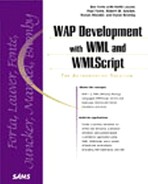Understanding Emulators
HTML is displayed in Web browsers that run on most PCs. As you write your HTML on a PC, usually a PC with a browser installed, testing your code is pretty simple. In fact, many HTML editors feature integrated HTML browsers so you see what the output will look like while you work.
WML is displayed on microbrowsers on WAP-enabled devices. And you definitely do not write your WML code on a device such as a phone. As such, testing your WML code usually involves writing the code on your PC, deploying it to a WAP server, and connecting to an appropriate URL on your device. This is obviously not as simple as browsing your HTML code.
The important thing to remember is that devices do not parse and display WML. Rather, devices contain browsers that parse and display WML. And those browsers are software applications, usually embedded on a chip within the device.
But that software application, or some version of it, can also run on your PC. And that's where emulators come into play. Emulators are just that—virtual devices that emulate phones on your PC that you can interact with to test your code without having to use an actual device. In fact, some emulators even allow you to browse local files so that you do not even need a WAP server or gateway.
Here are the primary reasons to use emulators:
Emulator use is the fastest way to test new or revised WML code.
Most emulators also feature useful debugging options (such as the ability to inspect variables or retrieved source).
Emulators feature the ability to test displays on multiple devices—more devices than you might actually have.
Some emulators feature complete development environments that can be used to greatly simplify and enhance the development process.
Several emulators are available; the three primary ones are
Ericsson WapIDE SDK Browser
Nokia WAP Toolkit
Phone.com's UP.Simulator
In this appendix, I'll briefly describe each of these tools and their features, and I'll also tell you where you can find them.
Note
For your convenience, the accompanying CD contains versions of some of these emulators. Refer to Appendix G, "CD-ROM Contents," for a complete list of the software on the CD.
So which of these emulators should you use? The answer is all of them. Other than download time and disk space, there is nothing to lose by installing them all. And the upside? A greater array of testing environments will help you write code that runs well on as many devices as possible.
Caution
Before you read any further, there is one very important point I must make. Emulators are just that, emulators. They are not real devices, and don't always behave exactly like the devices they are emulating. Emulators are invaluable development and testing tools, but you must never rely solely on emulators for your testing. When all is said and done, there is no substitute for testing on real devices and on as many of them as possible.
